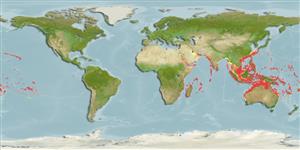Classification / Names
Common names from other countries
Main reference
Size / Weight / Age
Max length : 100.0 cm TL male/unsexed; (Ref. 89972); common length : 90.0 cm TL male/unsexed; (Ref. 5450)
Length at first maturity
Lm 61.1, range 61 - ? cm
Environment
Marine; reef-associated; oceanodromous (Ref. 51243); depth range 1 - 300 m (Ref. 28016)
Climate / Range
Subtropical, preferred 27°C (Ref. 107945); 30°N - 32°S, 29°E - 123°W (Ref. 5222)
Distribution
Indo-Pacific: Red Sea to South Africa and eastward to Ducie in the Pitcairn Group, north to Japan, south to New South Wales and Lord Howe Island. Migration report from the eastern Mediterranean Sea (Ref. 6489, 5385) may be based on Epinephelus coioides specimens.
Countries | FAO areas | Ecosystems | Occurrences | Introductions
Short description
Dorsal
spines
(total): 11;
Dorsal
soft rays
(total): 13-16;
Anal
spines: 3;
Anal
soft rays: 8. Color of head and body pale greenish grey or brown with round dark spots that vary from dull orange-red to dark brown, centers darker than the edges. A large black blotch (or group of black spots) often visible on body at the base of last 4 dorsal-fin spines. Five sub vertical dark bars may be present on body. Dark spots on soft dorsal, caudal and anal fins of juveniles are so close that the pale interspaces form a white reticulum. 95-112 scales in longitudinal series. Scales on body ctenoid in juveniles, becoming cycloid in adults except the area beneath and posterior to pectoral fins. Pyloric caeca 16-18. Further characterized by: elongate body, depth contained 3.0-3.6 times in SL; large head, length is 2.1-2.4 times in SL; snout length 2.0-2.4 times in upper-jaw length; interorbital area narrow, flat to slightly concave, interorbital width 6.8-8.1 times in HL and 3.1-4.0 times in upper jaw length; broadly rounded preopercle, serrae at angle of preopercle slightly enlarged; upper edge of operculum almost straight; posterior nostrils distinctly larger than anterior nostrils; maxilla reaching well past eye, greatest width about twice suborbital depth, maxilla width 6.8-8.1% of standard length; upper-jaw length 21-24% of SL; 2-5 rows of teeth on midlateral part of lower jaw; inner teeth at symphysis of upper jaw are longer than the fixed canines at front of jaw (Ref. 89707). Differs from E. howlandi by its more elongate body and closer-set spots (Ref. 37816).
IUCN Red List Status (Ref. 115185)
Threat to humans
Reports of ciguatera poisoning (Ref. 9710)
Human uses
Fisheries: minor commercial; aquaculture: commercial; gamefish: yes
Tools
Special reports
Download XML
Internet sources
Estimates of some properties based on models
Phylogenetic diversity index
PD50 = 0.5000 many relatives (e.g. carps) 0.5 - 2.0 few relatives (e.g. lungfishes)
Trophic Level
4.1 ±0.68 se; Based on food items.
Resilience
Low, minimum population doubling time 4.5 - 14 years (K=0.1-0.17; tm=5-6; Fec = 354,989)
Vulnerability
High vulnerability (59 of 100)
Price category
